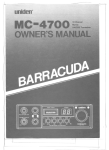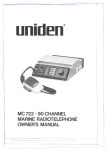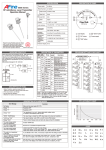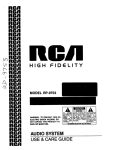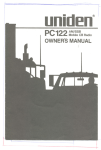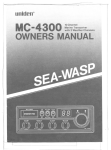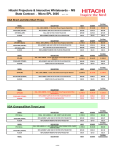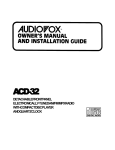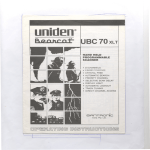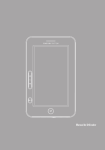Download Uniden D1880 Series Specifications
Transcript
-- "" ~ '= uniden@ @ UBC 175xL t. J ~ 16 CHANNEL SCANNING RADIO .. .. .. .. .. .. . 9 BAND COVERAGE CRYSTAL FREE AUTOMATIC SEARCH DIRECT CHANNEL ACCESS AUTOMATIC SQUELCH CHANNEL LOCKOUT TRACK TUNING SELECTIVESCAN DELAY SPEED CONTROL AIR CRAFT BAND PRIORITY CHANNEL WEATHER SEARCH MANUALUP/DOWN SEARCH §iinlronlc) AGENCIES PTY. LTD. (Q)~[§~~lJ~~@ ~~~lJ~(UJ(9lJ~(Q)~~ -~ - <::::::C TABLE OF CONTENTS Technical Specifications. . . . . . . . . .3 Unpacking 4 General Description. . . . . . . . . . . . .4 MemoryBack-up 4 Optional Antenna 4 Antenna 5 Controls 5 Display ProgramKeys Operation Keys Operating the Scanner. Programming Search Manual Step-Search. . . . . . . . . . . . 10 Manual Channel Selection. . . . . . .10 Lockout 10 6 6 6, 7 . . . . . . . . . .7 8 8 Delay Priority Weather 11 11 11 Speed EITor Message External Speaker UserHints Birdies TroubleChecks 12 12 12 12 12 13 WARNING UNIDEN DOES NOT REPRESENT THE UNIT TO HAVE BEEN WEATHERPROOFED. TO REDUCE THE RISK OF FIRE OR ELECTRIC SHOCK, DO NOT EXPOSE THIS APPLIANCE TO RAIN OR MOISTURE. A fA CAUTION: TO REDUCE THE RISK OF ELECTRIC SHOCK, 00 NOT REMOVECOVER(OR BACK). NO USER-SERVICEABLE PARTS INSIDE. REFER SERVICING TO QUALIFIED SERVICE PERSONNEL. The lightning flash with arrowhead symbol, within an equilateral triangle, is intended to alert the user to the presence of uninsulated"dangerousvoltage" within the product's enclosure that may be of sufficient magnitude to constitute a risk of electric shock to persons. The exclamation point within an equilateral triangle is intended to alert the user to the presence of important operating and maintenance (servicing) instructions in the literature accompanying the appliance. For future reference, write in the model number and serial number below. You will find them on the bottom of the unit. Model No. Serial No. Purchased from: Date 2 --- =r ~ TECHNICAL SPECIFICATIONS Size: Weight: Power: Antenna: RF Sensitivity: IF Selectivity: Frequency Coverage: Channel Capacity: Audio Output: Rear Apron Connections: Front Panel Controls: 240W x 62H x 180Dmm 740g AC Adaptor Telescoping antenna (supplied) Connection provided for external antenna (50-70 ohms) 0.3 microvolts 66-88 & 136-174 MHz 0.5 microvolts 406-512 MHz, ( f: 3 KHz deviation 12 dB SINAD) 0.8 microvolts 118-136 MHz, (60% MOD 12 dB SINAD) -55 dB @ f:25 KHz 66-88 MHz 118-136 MHz 136-144 MHz 144-148 MHz 148-174 MHz 406-420 MHz 420-450 MHz 450-470 MHz 470-512 MHz 16 1W, 8 ohms, 10% THD AC Adaptor Connector External Antenna Jack Ex~rnal Speaker Jack Volume (on/off), Squelch (Auto Squelch) SPECIFICATIONS ARE TYPICAL AND SUBJECT TO CHANGE WITHOUT NOTICE. 3 1 -=== <:::: UNPACKING Carefully remove all units from the shipping carton. If there is any visible damage, DO NOT attempt to operate the equipment. Notify your dealer or shipping carrier immediately. Keep the shipping carton and packing materials, as well as all printed material. The carton serves as an excellent method to transport the Uniden@ Bearcat@ 175XL to other locations. The following parts are included in this carton: Uniden@ Bearcat@ 175XL Operating Instructions Telescoping Antenna AC Adaptor GENERAL DESCRIPTION Scanning is easy and fun with the Uniden@ Bearcat@ 175XL. Advanced electronics provide programmable operation and dependability. The rubber key top keyboard has been designed for comfort and operating efficiency. It is divided into two sections: PROGRAM, which allows you to command any frequencies (VHF/UHF) on its 16 channels; and OPERATION. Volume and squelch levels are controlled by smooth acting knob adjustments. An 8-digit, back-lighted LCD display provides frequency, channel, lockout, delay, priority, weather search and memory loss information. A unique capacitor type memory back-up eUminates the need for batteries. The case is constructed of high impact plastic. MEMORY BACK-UP The Uniden@ Bearcat@ 175XL is equipped with a unique capacitor type memory back-up. The capacitor back-up will provide approximately four hours of memory retention in the event of a power interruption. When memory loss has occurred, the memory loss message will be displayed. It will remain on the display until any operating key is pressed. The system is completely automatic and requires no maintenance. INSTRUCTIONS OPTIONAL ANTENNA An external antenna may be helpful in fringe areas. Always use 50-70 ohm coaxial cable for lead-in. For lengths in excess of 50 feet, RG8AU Iow-loss foam dielectric coax is recommended. Your scanner is equipped with a standard automotive type antenna connector. A mating plug (optional) must be used. 4 ~-' o:q:: 1 -..... <:: '!"'~ ANTENNA The telescopic antenna provided with the Uniden@ Bearcat@ 175 XL is recommended for most monitoring. Insert the antenna swivel connector into the antenna jack located on the back panel (fig. 1). Extend the antenna. The swivel connector allows the antenna to be angled if desired. For weak signal reception or electrically noisy locations, an external antenna may be helpful. You can also store your antenna in the handy compartment located under the unit. Simply remove the antenna from the connector and snap it in place. When you are ready to set it up again unsnap the antenna and plug it in. Telescoping Antenna EXT.SP. Figure 1 CONTROLS 1. On-Off/Volume: Turns the receiver power on or off, and also varies the audio output level (fig. 2). 2. Squelch: Eliminates the annoying "rushing" sound that is present between transmissions when no signal is being sent. Proper setting of this control keeps the receiver"quiet" and allows scanning until a signal is received (fig. 2). The 175XL also has an automatic squelch setting marked "AUTO". Turn the squelch control to "AUTO" for a preset level that allows all clear signals to be received. Squelch Control ON/OFF Volume Control Figure 2 5 ~ " 1 ! =0..- -"-- --- I~ DISPLAY Your Uniden@Bearcat@ 175XL has an 8-digit backlighted display which indicates the channel and frequency being monitored as well as lockout, delay, priority, weather (WX) search and memory loss (fig. 3). All of the functions of the display will be discussed in detail later in the programming section. Frequency in MHz Memory Channel Number LOCKOUT"" DELAY PRIORITY [ 7 C , ..-.-l-- UBC 175XL 16 CHANNELSCANNINGRADIO MEMORY LOSS )1 8 ~I 9 , I 5 ~ 6 ~ )I 2 I ~I 3 ~ [ 0 )1. ' I LI C ~ ~ WX SEARCH [ 4 ) [ 1 c' 'I El I PRI I LIMIT 1 SPEED I wx I SRCH, I HOLD I DELAY I SCAN , I I LOCKOUT' MANUAL I Figure 3 PROGRAM KEYS Numeric keys 0 through 9 and []] your scanner. 0 are used to program the frequencies into allows frequencies to be entered into the 16 memory chan- nels for scanning. OPERATION KEYS [ DELAY Provides a 3 second delay on any channel to receive a reply )transmission before resuming search or scan. Delay is retained in memory. LIMIT SRCH HOLD I Enters two selected frequencies Also when receiver is stopped LIMIT permits manual searching cy at a time. Search limits will ) as upper and lower search limits. on a signal in the search mode, lower in frequency, one frequenbe retained in memory. Starts search operation. search. Also when receiver is stopped on a signal in the ) Stops search mode, HOLD permits manual searching higher in frequency, one frequency at a time. 6 :r: .---... 1 ---= <::::::c: PRI I wx I I Samples channel 1 every three seconds regardless of other operational settings. Priority function will be retained in memory. ) Searches all seven NOAA weather frequencies the one actively broadcasting in your area. until locking on SPEED I Select high (15 channels per second) or Iow (5 channels per second) scan speed. LOCKOUT~ Locks out reception of signals on any selected channels during scanning. Lockout is retained in memory. SCAN I Starts scan of all memory channels that are not locked out. I MANUAL I Stops scan or search. Steps scanner individually through all channels in the selected bank(s). Also permits Direct Channel Access. OPERATING THE SCANNER The Uniden@ Bearcat@ 175XL has 16 memory channels each of which can be I programmed to store one frequency. When SCAN is pressed, each of the programmed frequencies will be sampled in sequence, but locked out channels will be skipped. ~ In each programming example, the keys to be pressed are listed in sequence after the word PRESS. After the word "Display" will be an illustration of the actual displayed data. Follow the examples carefully, and programming will be easy. Plug the AC power cord into a standard 220 Vac wall outlet and into the AC .:! , Power receptacle (fig.1) on the radio. Slip the cord into the retaining channel on the bottom of the unit to avoid accidental disconnection. Turn the unit ON by rotating the ON-OFF volume switch clockwise. Press MANUAL key and adjust the "SQUELCH" CONTROL (fig. 2) clockwise until you hear background noise; then turn it back counterclockwise until the noise disappears. If you know the exact frequencies you wish to Scan, proceed with "Programming". If you do not know the frequencies of the agencies (Le., police, fire, weather, etc.) you wish to scan, check with your dealer. Active frequencies can also be found through "Search". 7 -----.. .~ tI ~ <:::;" PROGRAMMING Example: To program 162.550 MHz into channel 2: PRESS: 01 MANUAL I Display: 2 PRESS: [Q[!]0D00~ Display: 2 X X X . 16 2 . X X X 550 (Final zero to the right of the decimalwill enter automatically.) NOTE: X denotes the digits of the previously programmed frequency. To program 471.2375 into next channel (3). PRESS: MANUAL I I Each time MANUAL is pressed, the channel will advance. In this case it advances from 2 to 3. Display: PRESS: Display: 3 X X X X X X ~0[QD000~ L' 3 -, 1 ,1 .L- =-3 1 NOTE: X denotes the digits of the previously programmed frequency. Repeat this step until all desired channels have been programmed. If you make an error while entering a frequency, begin again. You may omit the decimal point on frequencies except those between 66 MHz and 88 MHz. Your Uniden@Bearcat@175XL has been designed to enter this automatically. On Iow band (66-88 MHz) you must press the decimal point key. SEARCH Your Uniden@ Bearcat@ 175XL will search for unknown signals between two frequency limits in the same band (66-88 MHz, 118-136 MHz, 136-174 MHz, or 406-512 MHz). The Frequency Allocation listing in the back of the manual will give you an indication of what you might expect to find in the various bands and frequency ranges. To SEARCH, enter the search limits in any sequence, making sure they are in the same band as shown above. 8 ~ ---' 1 Example: To search between 152.150 MHz and 155.575 MHz on channel 2: I PRESS: 01 Display: 2 PRESS: QJ~0DQJ01 Display: ---. -== -----.------ '== MANUAL X X .- 2 . X j 7 ~ C , X x X -' 0 1 C I LIMIT I (Final zero to the right of the decimal will enter automatically.) PRESS: QJ00D0001 Display: 2 LIMIT I 7'-'- '- 575SRCH PRESS: I I NOTE: X denotes the digits of the previously programmed frequency. When an active frequency is found, the SEARCH stops and the frequency is displayed. During your search, record (on paper) the frequency numbers you wish to retain as you identify them. Later you can program these individual frequencies into memory channels or press Wand the frequency displayed wiH immediately be programmed into the indicated channel. Search is not affected and may be continued. To remain on a frequency after the signal goes off the air: PRESS: I I may also press to improve .., I HOLD ~ You may now press HOLD to step higher in frequency which will sometimes produce clearer reception. You I I LIMIT to step lower in frequency again, reception or just to select a new frequency. If (!] is pressed, the frequency in the display entered into the memory channel being displayed. To resume searching SRCH [ PRESS: I will be within the same limits: I To remove search: I PRESS: MANUAL lor I SCAN I, search will turn off. 9 ---'-0-'-.q:: 1I ------ -._~= MANUAL STEP-SEARCH Your Uniden@ Bearcat@ 175XL has the ability to be stepped, one frequency at a time, either up or down throughout its search range. This feature is helpful in tuning in a frequency or for stepping to any new frequency within search limits. To Step-Search while in search mode: PRESS: [ HOLD PRESS: ( HOLD) I repeatedly to step upward to the desired higher frequency. OR: I PRESS: PRESS: HOLD I I LIMIT frequency. I I repeatedly to step downward to the desired lower MANUAL CHANNEL SELECTION If you wish to select a specific channel to monitor, two methods are provided: PRESS: MANUAL appears. I I repeatedly until the desired channel number OR, Direct Channel Access: I PRESS: I CHANNEL NUMBER'I MANUAL 1 LOCKOUT You may wish to lock out certain frequencies and skip over them when scanning. To program Locko.ut on a channel (example 5), first select that channel manually. PRESS: [!] I MANUAL PRESS: I I LOCKOUT' LOCKOUT The lockout message will be displayed. Display: To remove Lockout: PRESS: I LOCKOUT I again and the message will disappear. NOTE: If all channels are locked out, the scanner will go into manual mode. This may be eliminated by removing lockout from one channel. 10 ------.. l' 1 ! "",.. DELAY Your scanner can be programmed to pause for about three seconds after a transmission ends on any selected channel. This is useful when both sides of a conversation are transmitted on the same frequency. To program Delay on a selected channel: PRESS: PRESS: I MANUAL I step to that channel. DELAY I Display: DELAY I The delay message will be displayed To remove Delay: PRESS: DELAY' I The message will disappear. PRIORITY It is often desirable to be alerted to a transmission occurring on a channel other than that to which you are listening. The priority feature samples any frequency which has been entered into channel 1, every 3 seconds. If a signal is detected on the priority frequency, (channel 1) when sampled, the receiver will remain tuned in to it until the transmission ceases, at which time the scanner will revert to the. last mode of operation. To activate the priority function: PRESS: I PAl I The priority message will be displayed. I again and the priority message will disappear. To remove priority: PRESS: I PAl WEATHER Searches all seven NOAA weather frequencies until locking on the one actively broadcasting in your area. To search for local weather: PRESS: I PRESS: MANUAL' I I WX Display will indicate the weather frequency being received. 11 ,_..... <::'"' -~== To remove weather: PRESS: I MANUAL ~ or I SCAN ( , weather will turn off. SPEED The Uniden@Bearcat@17SXL has a high/Iow scan speed adjustment. Whenever the unit is turned on, the scan speed will automatically be high. Press the ISPEED I key to select the slow scan speed. to switch back to high. Press the ISPEED I key again ERROR MESSAGE To inform the user anytime an out-of-band frequency is stored in memory, the USC 175XL automatically displays "ERROR" in this event. The condition may arise when the user presses ENTER with an invalid number in the display. The user should simply enter an in-band frequency (see programming section) to clear the ERROR indication. EXTERNAL SPEAKER Although the internal speaker of the scanner will provide ample room volume, in some applications an external speaker may be desired. The external speaker should be plugged into the rear-apron jack (fig. 1) which will cut off the internal scanner speaker. The external speaker impedance should be 8 ohms. USER HINTS Your scanner is a versatile instrument. The following operating hints will help you use all of its features. I!J key when programming a desired 1. Always remember to press the frequency. 2. When disconnecting the AC adapter from the outlet, make sure the radio is turned off. You may wish to record your programmed frequencies (on paper) before disconnecting the AC adapter since memory will be lost in approximately 4 hours. 3. When memory is lost, simply reprogram the proper frequencies. Memory loss will be indicated by the appear9nce of non-user programmed frequencies in the display. 4. In case of strong interferring noise or signals, it may be desirable to move the unit to a different location, and under extreme conditions, reduce the length or change the angle of the antenna. 5. When operating the keyboard, it is important to press firmly in the center of the key with the tip of your finger. BIRDIES All radios are subject to receiving undesired signals. If the Uniden@ Bearcat@ 17SXL stops during search mode and no sound is heard, simply press the I SRCH , key one or more times- to resume. 12 ~ ----... 1 -<::::::C NOTE: Environmental sources of interference such as power line noise, a television set or other electrical appliances may generate signals that create the same effect. Moving the scanner may eliminate such interference. TROUBLE CHECKS 1. Scanner is not working properly. A. Is radio plugged in and receiving power? B. Is OFF-ON-VOLUME switch on? C. Go through the complete section on programming all functions. 2. Signal is weak or distorted. A. Check antenna-adjust height. B. Go through all the checks in number 1. 13 ----- T 1 ,........... ~. 5anlronlc ) AGENCIES PTY. LTD. 13 GAREMA CIRCUIT, KINGSGROVE PHONE 7581522, TELEX AA73170 FAX 7502722 P.O. Box 12, Kingsgrove, NSW 2208 BRISBANE: 3/12 BANDALL ST SLACKS CREEK, OLD 4127 PHONE 07 2901188 MELBOURNE: 446-448 BELL STREET EAST PRESTON VIC 3072 PHONE: (03) 484 0373 PERTH: 23 GEDDES ST., BALACATTA W.A. 6021 PHONE: (09) 3443937 UBSNO1105GZ (GRN) Printed in Taiwan -----... l' 1 ,














